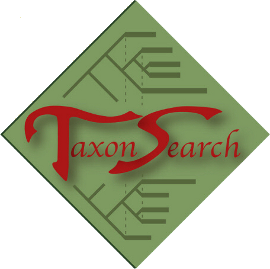About TaxonSearch
The suprageneric taxa used in the taxonomy of life have evolved during more than two centuries of use. Some taxa are long forgotten while others were minted yesterday. The structure and application of phylogenetic definitions, likewise, have evolved since their first use in the mid 1980's. Several databases have emerged in the last decade that compile genera and species. TaxonSearch, by contrast, is devoted to suprageneric taxa. The aim is to provide practicing taxonomists with an efficient tool for logging, locating, and sharing information regarding suprageneric taxa and available phylogenetic definitions.Practicing taxonomists ought to be able to rapidly locate basic information about suprageneric taxa (author, date of publication, bibliographic reference), any associated phylogenetic definitions (author, date of publication, definitions, type of definition, specifiers, etc.), or the estimated age range of a taxon (millions of years). TaxonSearch will locate records based on any aspect, or combination of aspects, of the features that are logged for each taxon record in the selected compilation (clade). Given the pace of phylogenetic work and the increasing number of phylogenetic definitions, efficiently locating information about supraspecific taxa is a growing and critical need.
Each taxon record in a TaxonSearch compilation is divided into six sections: Clade, Taxon, Active Phylogenetic Definition, Inactive Taxon Status, Current Age Range, and Definitional History. These sections organize information about suprageneric taxa in a series of fields that permit efficient browsing and searching. For information on the meaning of these fields, see Glossary of Terms on the navigational sidebar (also Sereno et al., in review). For examples of how to use TaxonSearch, see Using TaxonSearch for more information).
Facilitating Consensus
TaxonSearch was created to facilitate, rather than impose, consensus and consistency of usage of suprageneric taxa and their definitions. Unlike the PhyloCode, TaxonSearch compilations do not contain "converted" or "established" taxa or phylogenetic definitions. The phylogenetic definitions and opinions expressed in TaxonSearch compilations belong to the compiler, unless cited otherwise. TaxonSearch encourages consensus and consistency of usage via compilation. Compilation encourages an understanding of the historical taxonomic content of taxa and acknowledgement of prior phylogenetic definitions. Although users cannot alter a TaxonSearch compilation, comments can be posted to any taxon record.Site Guidelines
Publishing a compilation in TaxonSearch must be linked to a publication in a recognized journal. A given compilation has a term limit of five years. If not updated with a new version, the compilation will be available to another compiler (a secondary compiler) for updating. Overlapping compilations are not permitted; users may add comments to any taxon record to express an opposing point of view.The fundamental operating guidelines are:
- New compilations must be associated with a publication in review
- Compilations are archived on the Compilation Archive page and may not be edited after posting
- New versions of compilations may be posted at any time
- New compilations may be submitted for uploading onto the Archive page
- Each compiler has a 5-year term once a compilation is posted; if that term expires without a significant update, a secondary compiler may request access and update or otherwise edit the compilation; access may also be granted to a secondary compiler at any time with the express permission of the original compiler
- Significant overlap in taxon records between compilations (i.e., more than a single basal or terminal taxon) serves no purpose and is not permitted
- Literature Cited files that provide full bibliographic references to citations in taxon records are encouraged but not required; they may be edited at any time
- Site visitors may post comments on any taxon record via email
Output
Output files summarize data in the TaxonSearch file. A pie chart (taxon/definition status) summarizes the percent of active versus inactive taxa and the prevalence of the different types of phylogenetic definitions (for definitions of terms see Using TaxonSearch). A bivariate graph (taxon/definition accumulation) shows the accumulation of active taxa and phylogenetic definitions over time.References
| P. C. Sereno. 2005. | The logical basis of phylogenetic taxonomy. Systematic Biology 54:595-619. |
| Sereno, P. C. in review. | A phylogenetic taxonomy for stem Archosauria (Tetrapoda: Reptilia). Journal of Vertabrate Paleontology. |
| Sereno, P. C., McAllister, S., and Brusatte, S. L. 2005. | TaxonSearch: a relational database for suprageneric taxa and phylogenetic definitions. PhyloInformatics 8:1-21. |







